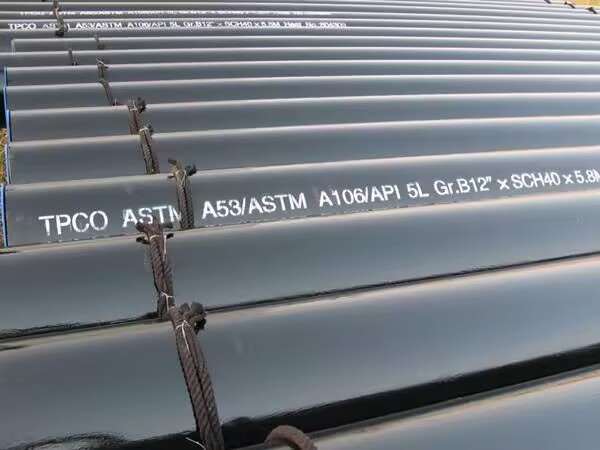Different types and grades of carbon steel tubes have different chemical and physical properties, and each type of carbon steel tube has different characteristics and application fields. Central Steel is a professional carbon steel pipe manufacturer and supplier with the grade, size and price to suit your needs. The following is Central Steel's description of the characteristics, specifications and applications of different grades of seamless carbon steel pipes:

Chemical composition:
|
|
Grade A |
Grade B |
Grade C |
|
Carbon max. % |
0.25 |
0.30 |
0.35 |
|
Manganese % |
0.27 to 0.93 |
0.29 to 1.06 |
0.29 to 1.06 |
|
Phosphorous, max. % |
0.035 |
0.035 |
0.035 |
|
Sulfur, max. % |
0.035 |
0.035 |
0.035 |
|
Silicon, min.% |
0.10 |
0.10 |
0.10 |
|
Chrome, max. % |
0.40 |
0.40 |
0.40 |
|
Copper, max. % |
0.40 |
0.40 |
0.40 |
|
Molybdenum, max. % |
0.15 |
0.15 |
0.15 |
|
Nickel, max. % |
0.40 |
0.40 |
0.40 |
|
Vanadium, max.% |
0.08 |
0.08 |
0.08 |
Mechanical properties:
|
|
Grade A |
Grade B |
Grade C |
|
Tensile Strength, min., psi |
48,000 |
60,000 |
70,000 |
|
Yield Strength, min., psi |
30,000 |
35,000 |
40,000 |
A/SA53-Grade B
ASTM A53 and ASME SA53 are suitable for mechanical and pressure applications, as well as for general use in steam, water, gas and air lines.
Chemical composition:
|
|
Grade A |
Grade B |
|
Carbon max. % |
0.25 |
0.30 |
|
Manganese % |
0.95 |
1.2 |
|
Phosphorous, max. % |
0.05 |
0.05 |
|
Sulfur, max. % |
0.045 |
0.045 |
|
Chromium, max. % |
0.40 |
0.40 |
|
Copper, max. % |
0.40 |
0.40 |
|
Molybdenum, max. % |
0.15 |
0.15 |
|
Nickel, max. % |
0.40 |
0.40 |
|
Vanadium, max.% |
0.08 |
0.08 |
Mechanical properties:
|
|
Grade A |
Grade B |
|
Tensile Strength, min., psi |
48,000 |
60,000 |
|
Yield Strength, min., psi |
30,000 |
35,000 |
API 5L Grades B, X42, X52, X65
Pipeline steel, suitable for oil, gas and liquid transportation. The higher the grade, the higher the strength.
Chemical composition:
|
|
Grade B |
X42 |
X52 |
X60 |
X65 |
X70 |
|
Carbon max. % |
0.24 |
0.24 |
0.24 |
0.26 |
0.26 |
0.26 |
|
Manganese % |
1.2 |
1.4 |
1.4 |
1.4 |
1.65 |
1.65 |
|
Phosphorous, max. % |
0.03 |
0.03 |
0.03 |
0.03 |
0.03 |
0.03 |
|
Sulfur, max. % |
0.03 |
0.03 |
0.03 |
0.03 |
0.03 |
0.03 |
Mechanical properties:
|
|
Grade B |
X42 |
X52 |
X60 |
X65 |
X70 |
|
Tensile Strength, min.,MPa |
415 - 655 |
415 - 655 |
460 - 760 |
520 - 760 |
535 - 760 |
570 - 760 |
|
Yield Strength, min.,MPa |
245 |
290 |
360 |
415 |
450 |
485 |
Carbon steel pipe selection basis
1. Use environment
High temperature environment: A/SA106 B/C grade is preferred because of its excellent high temperature resistance.
Long distance transport: Choose API 5L pipeline for efficient transport of liquids and gases.
2. Pressure and strength requirements
Medium and low voltage systems: Use A/SA53 seamless B class.
High voltage system: Choose A/SA106 C or API 5L X.
3. Corrosion and fatigue properties
For corrosive environments, the corrosion resistance of carbon steel pipes can be improved by external coating or lining treatment.
Conclusion
According to the requirements of the application, it is important to select the appropriate grade of carbon steel pipe. Different grades of carbon steel tubing provide reliable solutions for structural support, energy delivery and industrial production through their specific chemical and physical properties.